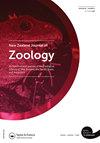澳大利亚-太平洋新球织蜘蛛属Socca的分类和系统(蜘蛛目:蜘蛛科)
IF 1.1
4区 生物学
Q3 ZOOLOGY
引用次数: 7
摘要
摘要建立了新的澳太圆织蛛属(Socca),包括12个来自澳大利亚的物种:脓疱蛛属(Voccenaer,1841)梳蛛。nov.(模式种;也存在于新西兰);S.arena sp.nov.,S.australis sp.nov.S.caiguna sp.nova,S.elvispresleyi sp.nova.,S.eugenii sp.nov.Johnywarreni sp.noval.,S.kullmanni sp.novar.,S.levyashini sp.novat.,S.pleia sp.novad.,S.seniodada(Simon,1908)comb。nov.(=Araneus senicodus simplex Simon,1908 syn.nov.)和S.sydneyica(Keyserling,1887)comb。nov.(=Epeira inquieta Keyserling,1887 syn.nov.)。Socca gen.nov.包括中等剑麻的夜间织球蜘蛛。它不同于其他的倒钩龙属,在腹部后方有五个结节,雄性足须有一个三分的末端隆起。雌性的表翼板大约和长一样宽,而花冠延长并向后延伸超过表翼板。对五个Socca gen.nov.物种的样本进行线粒体基因细胞色素c氧化酶亚基1(COI)的测序。初步的系统发育支持我们的形态物种,但不能根据形态确认物种群,并表明新西兰的S.pustullosa梳。nov.种群起源于澳大利亚东南部。Zoobank LSID:urn:LSID:Zoobank.org/pub:FA8B2B0-B797-4122-B4C1-1EF14B999BF2本文章由计算机程序翻译,如有差异,请以英文原文为准。
Taxonomy and systematics of the new Australo-Pacific orb-weaving spider genus Socca (Araneae: Araneidae)
ABSTRACT
The new Australo-Pacific orb-weaving spider genus Socca is established to include 12 species from Australia: Socca pustulosa (Walckenaer, 1841) comb. nov. (type species; also present in New Zealand); S. arena sp. nov., S. australis sp. nov. S. caiguna sp. nov., S. elvispresleyi sp. nov., S. eugeni sp. nov., S. johnnywarreni sp. nov., S. kullmanni sp. nov., S. levyashini sp. nov., S. pleia sp. nov., S. senicaudata (Simon, 1908) comb. nov. (= Araneus senicaudatus simplex Simon, 1908 syn. nov.) and S. sydneyica (Keyserling, 1887) comb. nov. (= Epeira inquieta Keyserling, 1887 syn. nov.). Socca gen. nov. includes medium-sised, nocturnal orb-weaving spiders. It differs from other backobourkiine genera by five tubercles posteriorly on the abdomen and a tri-partite terminal apophysis of the male pedipalp. The epigyne plate in females is about as wide as long and the scape elongate and reaches posteriorly beyond the epigyne plate. Specimens of five Socca gen. nov. species were sequenced for the mitochondrial gene cytochrome c oxidase subunit 1 (COI). The preliminary phylogeny supports our morphological species but does not confirm species-groups based on morphology and suggests that New Zealand S. pustulosa comb. nov. populations originate from south-eastern Australia. Zoobank LSID: urn:lsid:zoobank.org:pub:FA8B2BB0-B797-4122-B4C1-1EF14B999BF2
求助全文
通过发布文献求助,成功后即可免费获取论文全文。
去求助
来源期刊
CiteScore
2.80
自引率
0.00%
发文量
20
审稿时长
>12 weeks
期刊介绍:
Aims: The diversity of the fauna of the southern continents and oceans is of worldwide interest to researchers in universities, museums, and other centres. The New Zealand Journal of Zoology plays an important role in disseminating information on field-based, experimental, and theoretical research on the zoology of the region.

 求助内容:
求助内容: 应助结果提醒方式:
应助结果提醒方式:


